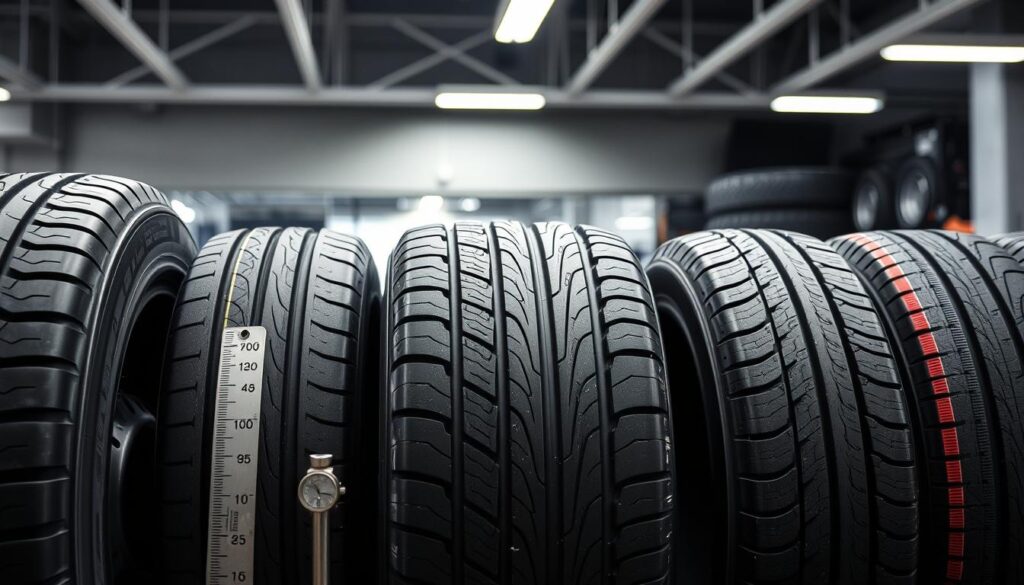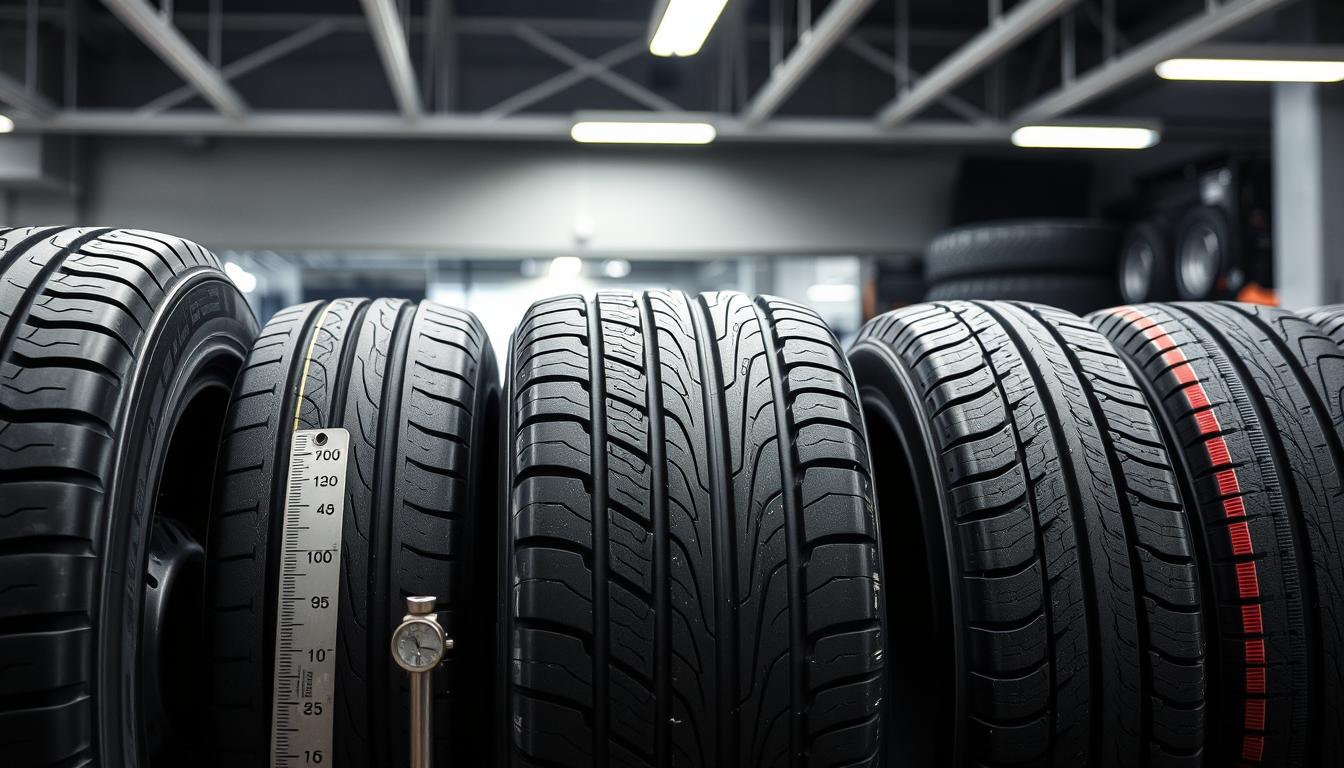Tires are key to our safety and performance on the road. Yet, understanding tire size and load ratings can be tough. This guide explores “load g,” a vital factor in choosing the right tires.

A close-up view of a tire sidewall displaying the load index markings, surrounded by mechanical tools and a soft-focus background of a garage setting, highlighting the importance of tire specifications and safety.
Choosing the right tires is more than just looks. It affects your safety, fuel use, and how your car handles. Knowing about load g and tire size helps you make better choices. This improves your driving and keeps everyone safe.
Key Takeaways
- Tire load ratings are essential for vehicle safety and performance
- Load g is a critical factor in tire selection that impacts handling, comfort, and fuel efficiency
- Decoding tire size information can help you choose the right tires for your vehicle
- Proper tire maintenance is crucial for maintaining optimal load rating performance
- Seasonal variations can affect tire load capacity and should be considered in tire selection
Understanding Tire Load Ratings and Their Importance
Tire load ratings are key for vehicle safety and performance. They show the maximum weight a tire can handle. This ensures good handling, stability, and fuel efficiency. Knowing about tire load capacity is vital for all vehicles.
Impact on Vehicle Safety and Performance
Tire load ratings affect a vehicle’s safety and performance. Using tires that are too light or too heavy can cause problems. It can lead to poor handling, longer braking times, and even tire blowouts.
Choosing the right tire load rating for your vehicle’s weight is important. It makes sure the tires can handle the load. This provides safe and responsive driving.
Legal Requirements and Regulations
Tire load ratings must follow strict legal rules and industry standards. Manufacturers must make tires that meet or exceed these load capacities. This is crucial for keeping vehicles safe and avoiding legal trouble.
| Vehicle Type | Minimum Tire Load Rating |
|---|---|
| Passenger Cars | 800 lbs (362 kg) |
| Light Trucks | 1,000 lbs (454 kg) |
| Commercial Vehicles | 1,200 lbs (544 kg) |
It’s important to understand tire load ratings for your vehicle’s safety and performance. Following regulations and picking the right tires for your vehicle ensures a better driving experience. You’ll enjoy smoother, more efficient, and safer rides.
What is Load g and Its Significance in Tire Selection
Choosing the right tires for your vehicle is important. The load g rating, or load index, shows the maximum weight a tire can carry. It’s key to make sure your vehicle can handle the weight of passengers, cargo, or both.
The load g rating depends on the tire’s design and materials. Tires with a higher rating can carry more weight. This makes them good for bigger or heavier vehicles. On the other hand, tires with a lower rating might not be enough for your vehicle’s needs, affecting safety and performance.
It’s vital to know how load g rating, tire selection criteria, and maximum load capacity work together. By picking tires with the right load g rating, you ensure your vehicle’s safety and performance on the road.
| Tire Load Index | Maximum Load (lbs) | Maximum Load (kg) |
|---|---|---|
| 90 | 1,323 | 600 |
| 95 | 1,521 | 690 |
| 100 | 1,764 | 800 |
| 105 | 1,984 | 900 |
The table shows how the load g rating affects a tire’s maximum load. By choosing tires with the right load g rating, you make sure your vehicle meets your driving needs.
“Choosing the right tires with the correct load g rating is essential for the safety and performance of your vehicle. It’s a critical factor that shouldn’t be overlooked.”
Decoding Tire Size Information: A Complete Breakdown
Understanding tire sizes can seem hard, but knowing the basics helps a lot. Each part, from width to speed rating, affects how well your car performs and stays safe.
Width, Aspect Ratio, and Construction
The tire’s width is the first thing you see, measured in millimeters. It affects how your car handles and stays stable. The aspect ratio, as a percentage, shows the sidewall’s height compared to the width. A lower ratio means the tire is for better performance, while a higher ratio is for a smoother ride.
The type of tire construction, radial or bias-ply, also matters a lot. Radial tires are more common and better for fuel, tread life, and handling than bias-ply tires.
Diameter and Load Rating Components
The tire’s diameter is in inches and shows its total height. It’s key for fitting right in your car’s wheel well. The load rating tells you the tire’s max weight it can handle without losing performance or safety.
Speed Rating Understanding
The speed rating tells you the tire’s top speed. It’s shown by a letter, from “L” for 75 mph to “Y” for 186 mph. This helps you pick the right tires for your car’s speed needs and the law.
Knowing about tire sizes helps you choose better for your car’s handling, safety, and performance. Use a tire size chart to find the best fit for your driving style.
| Tire Size Component | Description |
|---|---|
| Tire Width | Measured in millimeters (mm), this number represents the width of the tire’s tread. |
| Aspect Ratio | Expressed as a percentage, the aspect ratio indicates the sidewall height in relation to the tire width. |
| Tire Construction | The most common types are radial and bias-ply, which impact performance and durability. |
| Diameter | Measured in inches, the tire diameter represents the overall height, including the sidewall and tread. |
| Speed Rating | Indicated by a letter, the speed rating denotes the tire’s maximum sustained speed capabilities. |
“Understanding the key components of tire size information is essential for ensuring your vehicle’s performance and safety.”
How Load g Affects Your Vehicle’s Performance
The load g rating of your tires is key to your vehicle’s performance. It affects how well your car handles, brakes, and even how much fuel it uses. It also impacts how comfortable your drive is.
Tires with a higher load g rating give better grip and stability. This is especially true when making sharp turns or quick changes in direction. Such tires let you control your car more precisely and feel more connected to it.
The connection between tire pressure and load capacity is important. Tires that are the right size and pressure can handle your car’s weight better. This means they can stop your car faster and safer, making your drive safer.

| Performance Aspect | Impact of Higher Load g Rating |
|---|---|
| Handling | Improved grip and stability during cornering and maneuvers |
| Braking | Reduced stopping distance and enhanced safety |
| Fuel Efficiency | Improved fuel economy due to reduced rolling resistance |
In short, the load g rating of your tires is very important. Choosing the right tires can make your car handle better, stop faster, and use less fuel. This makes your drive safer and more enjoyable.
A dynamic scene showcasing a modern vehicle navigating a winding mountain road, emphasizing the impact of tire load on handling; the vehicle leans into the curves, with visible tire deformation and grip, surrounding scenery featuring lush vegetation and rocky terrain, sunlight filtering through trees, creating a sense of motion and stability.
Common Tire Load Ratings Explained
Choosing the right tires for your vehicle is key. Load ratings tell you how much weight a tire can handle. This is important for your vehicle’s safety and how well it performs. Let’s look at the load ratings for cars, light trucks, and big rigs.
Passenger Vehicle Ratings
Passenger cars have load ratings shown as a number followed by “lbs” (pounds). This number is the max weight a tire can carry. The higher the number, the more weight it can handle. Load ratings for cars range from 1,060 lbs to 4,080 lbs.
Tires with higher ratings are best for bigger vehicles or those carrying heavy loads.
Light Truck Specifications
Light truck tires, found on SUVs, pickups, and vans, use a load range instead of a single number. This range shows the tire’s weight capacity and the air pressure it needs. Load ranges start at “C” and go up to “E,” with “E” supporting the heaviest loads.
Commercial Vehicle Standards
Commercial tires, for big rigs and large trucks, have a more detailed system. They use a ply rating, where higher numbers mean they can carry more weight. Ply ratings for commercial tires range from 6 to 22.
| Vehicle Type | Load Rating System | Typical Range |
|---|---|---|
| Passenger Vehicles | Load Rating (lbs) | 1,060 lbs – 4,080 lbs |
| Light Trucks | Load Range (C-E) | C, D, E |
| Commercial Vehicles | Ply Rating (6-22) | 6 to 22 Ply |
Knowing about these load rating systems is vital. It helps you pick the right tires for your vehicle. This ensures your safety, performance, and meets industry standards.
Selecting the Right Tire Based on Load Rating
Choosing the right tire is key, and the load rating is a big part of that. It shows how much weight a tire can handle. Knowing this helps your vehicle run better and stay safe on the road.
To pick the best tire, follow these steps:
- Determine your vehicle’s weight. This includes everything in your car, like passengers, cargo, and extra stuff. Check your car’s manual or the placard on the driver’s side door jamb for this info.
- Consult the tire load index chart. This chart from tire makers and car sites shows how much weight different tires can carry. Match your car’s weight to the right load index to make sure the tires can handle it.
- Consider the intended use of your vehicle. If you often carry heavy loads or tow a trailer, you need tires that can handle more weight. For just driving around, standard load tires might be enough.
- Factor in driving conditions. Tires with higher load ratings can handle tough roads better, like bad weather or off-roading.
By following these steps and using the selection guide, vehicle weight, and load index chart resources, you can find the perfect tires for your car. This ensures your car performs well, stays safe, and meets legal standards.
A detailed close-up of various tire models arranged on a display, showcasing different load ratings, surrounded by tools for measuring tire specifications. The background is a sleek, modern automotive shop with soft lighting that highlights the textures of the tires.
“Choosing the right tire load rating is essential for maintaining your vehicle’s handling, stability, and safety, especially when carrying heavy loads or navigating challenging driving conditions.”
Safety Considerations When Dealing with Load Ratings
Choosing the right tire load rating is more than just numbers. It’s key to keeping your vehicle safe. The right load helps with your car’s balance, how it handles, and stops.
Weight Distribution Impact
Too much weight can mess up your car’s balance. This stress can make your tires wear out faster. It also makes your car harder to control, especially in bad weather.
Following the load ratings your car maker suggests is vital. It keeps your car stable and handles well.
Handling and Braking Effects
Wrong load ratings can hurt your car’s grip and braking. Tires that are too heavy or not inflated right can get too hot. This makes them less responsive to your steering and brakes.
This can cause your car to stop longer and increases the chance of skidding. It’s a big safety risk.
Matching your tires to your car’s load needs is not just a rule. It’s a safety must. Knowing how load ratings affect your car’s balance and safety lets you make better choices. This keeps you and your passengers safe.
| Tire Safety Consideration | Potential Impact |
|---|---|
| Proper Weight Distribution | Improved vehicle stability, reduced risk of swerving, fishtailing, and rollovers |
| Adequate Tire Grip and Support | Enhanced handling and braking performance, shorter stopping distances |
| Adherence to Manufacturer Recommendations | Maintaining the intended balance and safety characteristics of the vehicle |
Maximum Load Capacity: Understanding the Limits
Knowing your vehicle’s maximum load capacity is key for safety and performance. Going over the tire overloading limit can be dangerous. It can ruin your drive and risk your safety and others.
Finding out your vehicle’s maximum weight capacity is crucial. You can usually find this in your owner’s manual or on a placard inside the driver’s side door. Remember, this limit includes passengers, cargo, and the vehicle itself, not just the tires.
Carrying too much weight can cause problems. It can make your car harder to handle, increase stopping times, and even cause tire failure. It’s vital to stick to the load index limits for your vehicle’s safety and performance.
- Learn your vehicle’s maximum load capacity.
- Calculate the total weight of passengers, cargo, and the vehicle to avoid overloading.
- If you need to carry heavy loads, consider using tires with a higher load rating or finding another way to transport your items.
“Keeping your vehicle within its maximum load capacity is not just a legal requirement – it’s a matter of safety and responsible driving.”
Respecting your vehicle’s load limits ensures a safe and fun drive. It also keeps you and others safe on the road.
Seasonal Variations and Load Rating Implications
Tire performance and load capacity change with the seasons and weather. Knowing these changes is key to picking the right tires. It ensures your safety and vehicle handling.
Summer vs. Winter Performance
Summer tires work best in warm, dry weather. They offer great grip and handling. But, they don’t do well in cold temperatures because the rubber gets hard.
Winter tires are made for snowy, icy, and cold weather. They stay flexible and grip well, even in extreme cold. This means they handle heavy loads better.
Temperature Effects on Load Capacity
Tire pressure and load capacity change with temperature. In cold weather, tires hold less load because air pressure drops. In warm weather, air pressure goes up, which can be too much for the tire.
Seasonal tire performance and temperature impact on tires are important. They affect your vehicle’s safety and performance.
To keep winter tire load ratings right, check tire pressure often. Adjust it as the manufacturer suggests. This keeps the tire safe, improves safety, and makes driving comfortable all year.
Maintenance Tips for Optimal Load Rating Performance
Keeping your tires in good shape is key for safe driving. Always check the tire pressure. If it’s too low or too high, it can affect how your car handles.
Get a good tire pressure monitoring system. It helps you keep track of the pressure and make the right changes.
Don’t forget to rotate your tires regularly. This helps them wear evenly. Check your car’s manual or talk to a mechanic to find out when to rotate.
Watch how much tread your tires have. Less tread means less grip on the road. Replace them when the tread is too low, usually 2/32 of an inch.
FAQ
What is the purpose of tire load ratings?
Tire load ratings are key for vehicle safety and performance. They show the maximum weight a tire can handle. This is important for handling, fuel use, and tire life.
How do tire load ratings affect vehicle safety and performance?
Right tire load ratings are vital for a vehicle’s safety and performance. If tires are too light, handling and stopping can be bad. Too heavy, and tires wear out fast, might blow, and you could lose control.
What is the legal requirement for tire load ratings?
Tire load ratings must follow industry rules and safety standards. Not following these can lead to legal trouble and make the vehicle less safe.
What is the significance of the “load g” rating in tire selection?
The load g rating is very important when picking tires. It shows the tire’s maximum load capacity. Picking the right load g rating for your vehicle’s weight and use is key for safe and reliable driving.
How can I decode the information on a tire’s size and what does it mean?
Tire size info includes width, aspect ratio, construction, diameter, and load rating parts. Knowing these helps pick the right tires for your vehicle and driving needs.
How does load g affect vehicle handling and fuel efficiency?
The load g rating affects a vehicle’s handling, braking, and fuel use. Tires with a higher load g rating support more weight. This means better stability, cornering, and fuel economy.
What are the common tire load ratings for different vehicle types?
Tire load ratings differ for passenger vehicles, light trucks, and commercial vehicles. Passenger cars have lower ratings. Light trucks and commercial vehicles need higher ratings.
How do I select the right tire based on load rating?
When choosing tires, match the load rating to your vehicle’s weight and use. Use a load index chart and follow the manufacturer’s advice to pick the right tire.
What are the safety considerations when dealing with tire load ratings?
Choosing the right load rating is key for safety. Overloading can affect stability, handling, and braking. This can lead to loss of control or longer stopping times.
How do seasonal changes affect tire load ratings and performance?
Seasonal changes, like temperature changes, can affect tire load capacity and performance. Winter tires may have different ratings than summer tires. Temperature also affects tire pressure and load-bearing ability.
What are the key maintenance tips for ensuring optimal tire load rating performance?
Regular tire care, like checking pressure, rotation, and tread wear, is crucial. It keeps tires at their best load-bearing performance. This ensures safety, handling, and fuel efficiency.
